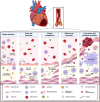Crosstalk between periodontitis and cardiovascular risk
- PMID: 39717783
- PMCID: PMC11663742
- DOI: 10.3389/fimmu.2024.1469077
Crosstalk between periodontitis and cardiovascular risk
Abstract
Recent demographic developments resulted in an aged society with a rising disease burden of systemic and non-communicable diseases (NCDs). In cardiovascular disease (CVD), a NCD with high morbidity and mortality, recent preventive strategies include the investigation of comorbidities to reduce its significant economic burden. Periodontal disease, an oral bacterial-induced inflammatory disease of tooth-supporting tissue, is regulated in its prevalence and severity by the individual host response to a dysbiotic oral microbiota. Clinically, both NCDs are highly associated; however, shared risk factors such as smoking, obesity, type II diabetes mellitus and chronic stress represent only an insufficient explanation for the multifaceted interactions of both disease entities. Specifically, the crosstalk between both diseases is not yet fully understood. This review summarizes current knowledge on the clinical association of periodontitis and CVD, and elaborates on how periodontitis-induced pathophysiological mechanisms in patients may contribute to increased cardiovascular risk with focus on atherosclerosis. Clinical implications as well as current and future therapy considerations are discussed. Overall, this review supports novel scientific endeavors aiming at improving the quality of life with a comprehensive and integrated approach to improve well-being of the aging populations worldwide.
Keywords: cardiovascular disease; dysbiosis; inflammation; innate immunity; periodontitis.
Copyright © 2024 Schulze-Späte, Wurschi, van der Vorst, Hölzle, Craveiro, Wolf and Noels.
Conflict of interest statement
H. Noels is founding shareholder of AMICARE Development GmbH. The remaining authors declare that the research was conducted in the absence of any commercial or financial relationships that could be construed as a potential conflict of interest. The author(s) declared that they were an editorial board member of Frontiers, at the time of submission. This had no impact on the peer review process and the final decision.
Figures



Similar articles
-
Periodontal diseases and cardiovascular diseases, diabetes, and respiratory diseases: Summary of the consensus report by the European Federation of Periodontology and WONCA Europe.Eur J Gen Pract. 2024 Dec;30(1):2320120. doi: 10.1080/13814788.2024.2320120. Epub 2024 Mar 21. Eur J Gen Pract. 2024. PMID: 38511739 Free PMC article.
-
Periodontal Treatment to Improve General Health and Manage Systemic Diseases.Adv Exp Med Biol. 2025;1472:245-260. doi: 10.1007/978-3-031-79146-8_15. Adv Exp Med Biol. 2025. PMID: 40111696 Review.
-
Low-grade inflammation in chronic infectious diseases: paradigm of periodontal infections.Ann N Y Acad Sci. 2006 Nov;1088:251-64. doi: 10.1196/annals.1366.032. Ann N Y Acad Sci. 2006. PMID: 17192571 Review.
-
Periodontitis and mechanisms of cardiometabolic risk: Novel insights and future perspectives.Biochim Biophys Acta Mol Basis Dis. 2019 Feb 1;1865(2):476-484. doi: 10.1016/j.bbadis.2018.12.001. Epub 2018 Dec 5. Biochim Biophys Acta Mol Basis Dis. 2019. PMID: 30529255 Review.
-
Periodontitis and Hypertension: Is the Association Causal?High Blood Press Cardiovasc Prev. 2020 Aug;27(4):281-289. doi: 10.1007/s40292-020-00392-z. Epub 2020 Jun 4. High Blood Press Cardiovasc Prev. 2020. PMID: 32500479 Review.
Cited by
-
Mediterranean diet component oleic acid decreases systemic impact of periodontal Porphyromonas gingivalis-infection in age: addressing role of stress resistance and microbiome.NPJ Aging. 2025 Jun 28;11(1):54. doi: 10.1038/s41514-025-00248-7. NPJ Aging. 2025. PMID: 40581654 Free PMC article.
-
Quantitative Evaluation of Postural SmartVest's Multisensory Feedback for Affordable Smartphone-Based Post-Stroke Motor Rehabilitation.Int J Environ Res Public Health. 2025 Jun 28;22(7):1034. doi: 10.3390/ijerph22071034. Int J Environ Res Public Health. 2025. PMID: 40724102 Free PMC article.
References
-
- United Nations Department of Economic and Social Affairs, P.D. . World Population Prospects 2022: Summary of Results. (2022) UN DESA/POP/2022/TR/NO. 3.
-
- World health organization . Cardiovascular diseases (CVDs) (2021). Available online at: https://www.who.int/news-room/fact-sheets/detail/cardiovascular-diseases....
-
- Geneva World Health Organization . Global oral health status report: towards universal health coverage for oral health by 2023. (2022).
Publication types
MeSH terms
LinkOut - more resources
Full Text Sources

